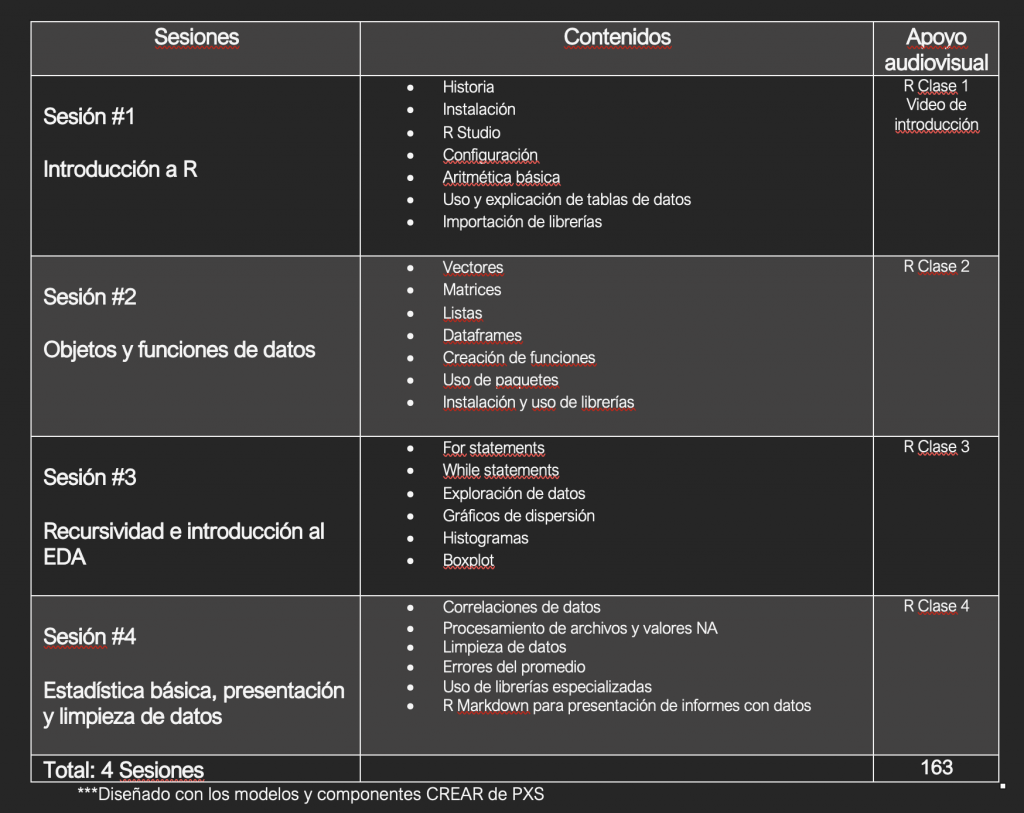
Start: 30 de Enero.


DESCRIPTION:
This course will allow participants to have a first approach to the world of programming using the R language. This will help them find effective solutions to large data sets using statistical methods, where the training objectives include learning computational thinking. , have a first approach to the world of programming and promote the algorithmic ability to find alternative solutions to conventional statistical software.
AIM:
• Introducir al pensamiento estructurado y analítico de desarrollo de algoritmos.
• Crear sus propias funciones que solventen problemas con datos.
• Proveer los conceptos básicos de creación en la programación algorítmica alrededor de los datos.
• Ampliar la gama de herramientas disponibles para el análisis de problemas estadísticos.
OUTPUT PROFILE:
At the end of the course the participant will be able to:
• Perform your own algorithmic functions for the development of data analysis
• Handle the R programming language from a basic development perspective.
• Use the system to solve basic problems with data
• Manipulate and import large volumes of data
ASSIGNMENTS AND ATTENDANCE:
- During Synchronous sessions: The person must pay attention, keep the microphone off and the camera on; in accordance with the Course Owner's instructions.
- Check that the Internet connection works correctly before starting class.
- Check that the audio and video work correctly on the device or computer.
- Review the virtual classroom in advance to know the resources that the Course Owner will use in the class and download them if indicated, as well as the requested corrections.
- Connect at least 5 minutes before the session.
SESIONES Y CONTENIDO:
SESIÓN 1
- Historia.
- Instalación.
- R Studio.
- Configuración.
- Aritmética básica.
- Uso y explicación de tablas de datos.
- Importación de librerías.
SESIÓN 2
- Vectores.
- Matrices.
- Listas.
- Dataframes.
- Creación de funciones.
- Uso de paquetes.
- Instalación uso de librerías.
SESIÓN 3
- For statements.
- While statements.
- Exploración de datos.
- Gráficos de dispersión.
- Histogramas.
- Boxplot.
SESIÓN 4
- Correlaciones de datos.
- Procesamiento de archivos y valores NA.
- Limpieza de datos.
- Errores del promedio.
- Uso de librerías especializadas.
- R Markdown para presentación de informes con datos.
***Diseñado con los modelos y componentes CREAR de PXS.
GENERAL COURSE INFORMATION:
- During Synchronous sessions: The person must pay attention, keep the microphone off and the camera on; in accordance with the Course Owner's instructions.
- Check that the Internet connection works correctly before starting class.
- Check that the audio and video work correctly on the device or computer.
- Review the virtual classroom in advance to know the resources that the Course Owner will use in the class and download them if indicated, as well as the requested corrections.
Connect at least 5 minutes before the session.
¿QUÉ ES R?
R is a free software environment and programming language that allows you to compile instructions focused on statistics & probability especially. Currently it is unot one of the most used languages for data interpretation and science.
BENEFITS:
- It includes many of the linear and nonlinear models used in statistics and industry.
- Thanks to the generation of graphics, it allows the evaluation and review of thousands of data in terms of processing seconds.
- The language allows you to create clean code that facilitates data management and interpretation.
- Works with the most popular UNIX, Windows and MacOS systems.
- Its use is free. It is only necessary to download the program from its official website.
CERTIFICADOS Y NOTIFICACIONES

CERTIFICADOS Y NOTIFICACIONES
To pass the course you must participate in all 4 sessions, both in form and time. You must complete all requested assignments and deliverables, attendance and PXS assessment.
Every session integrates analysis, readings, videos, participatory activities that encourage meaningful learning, interactivity, performance assessment, understanding goals and continuous feedback that allows knowledge to be progressively built with critical thinking, dynamics, creation, co-creation and reflection.
To receive the Certificate and the Badge you must complete the PXS Virtual Assessment that the team will send you within a maximum period of 5 days. Without sending the Evaluation, no certificate is provided, this is due to international licenses and certifications. Your feedback is very valuable to our entire PXS team.
The student must notify their respective Course Owner of absences or late arrivals, as well as any special situation or any irregularity that occurs during the training within a period of no more than 3 days, in order for them to complete the course. complete and the learning process.
At the same time, the participant can report any irregularity by the Course Owner such as late arrivals, early departures, non-compliance with the training content; among other concerns, to the email: infoventas@pxsglobal.com.
If you have suggestions about the development of the training, you can write to: adriana@pxsglobal.com. Please indicate your name, the name of the training and the Course Owner.
On behalf of PXS, if you as a participant wish to receive our list of courses, you will be incorporated into a database. If you do not wish to be part of the distribution list, please contact us at: infoventas@pxsglobal.com.

PHIL CROSBY
The success or failure of an organization is due to the effectiveness of the leader; This is more the rule than the exception. The leader is the one who sets the lifestyle for the organization. This occurs both in a direct positive action and in a